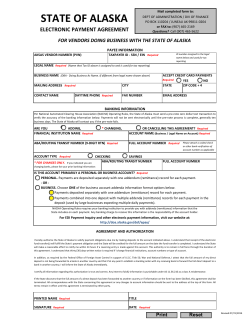
How does the Pacific SST influence Alaska?
How does the Pacific SST influence Alaska? Uma Bha; Dept. of Atmospheric Sciences & Geophysical InsEtute University of Alaska Fairbanks Pacific Anomalies Science and Technology Workshop Tuesday May 5, 2015 With contribuEons from: R. Thoman, P. Bieniek, D.A. Walker, M. Raynolds, M. Steele, and others Use Pacific SST to forecast: Tundra VegetaEon ProducEvity Alaska Winter Temperatures Tundra a maritime biome - Pac SSTs & SW Alaska? 1982-‐2013 Trends Summer Warmth Index Normalized Difference VegetaEon Index (NDVI) ‘Current’ North Pacific SST (Sea Surface Temperature) Pa;erns (2013-‐4) Nov-‐Jan SST pa;ern present in early 2014 acer Alaska had a record warm January (2014-‐5) SST pa;ern for a year later SAT 5 Warmest Januaries in Alaska (1977, 1981, 1985, 2011, 2014) Cold over Eurasia Average SST for 5 warmest Januaries Average Wind for 5 warmest Januaries Cold air from north Warm air from south What do Coldest 5 Januaries look like? Average SST for 5 Coldest Alaska Januaries Pacific SST anomalies > |1σ| 1958, 1962, 1963, 1986, 1987, 1992, 1994, 1996, 2005, 2014, 2015 1951, 1952, 1956, 1969, 1971, 1974, 1989, 1999, 2000, 2008, 2011 mean based on 1948-‐2014 SST and SAT anomalies Warm Pac • Composites show some similarity to those for Warm Alaska composites. • PosiEve phase of the PDO in North Pacific and negaEve ENSO phase (perhaps)! Final Comments • Could North Pacific circulation explain why SW Alaska tundra vegetation productivity has been declining? • Anomalously warm Alaska Januaries tend to occur when eastern US is cooler than normal. Related to proposed sea ice decline mechanism for hot Arctic/cold East coast? • Ocean temperatures tend to be warmer than normal south of Alaska during these extreme warm winters. • Anomalously Cold Alaska Januaries have opposite SAT and SST anomaly patterns to the warm case. • Equatorial Pacific was cooler than normal for both warm and cool AK Januaries. (too few cases?) • Composites based on Pac SST looked similar but not quite.
© Copyright 2025










